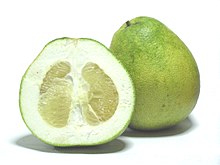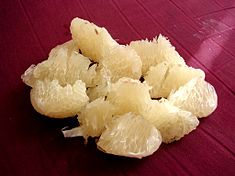Pomelo: Difference between revisions
No edit summary |
Rescuing 1 sources and tagging 0 as dead. #IABot (v1.6.1) (Ost316) |
||
| Line 61: | Line 61: | ||
''Citrus maxima'' is usually [[Grafting|grafted]] onto other [[citrus rootstock]]s, but may be grown from seed, provided the seeds are not allowed to dry out before planting. |
''Citrus maxima'' is usually [[Grafting|grafted]] onto other [[citrus rootstock]]s, but may be grown from seed, provided the seeds are not allowed to dry out before planting. |
||
The fruit is said to have been introduced to Japan by a Cantonese captain in the [[An'ei]] era (1772–1781).<ref>{{cite web|url=http://www.city.akune.kagoshima.jp/kanko/bontan.html |
The fruit is said to have been introduced to Japan by a Cantonese captain in the [[An'ei]] era (1772–1781).<ref>{{cite web|url=http://www.city.akune.kagoshima.jp/kanko/bontan.html|title=阿久根市: 観光・特産品(ボンタン)|publisher=City.akune.kagoshima.jp|date=|accessdate=2012-01-07|deadurl=yes|archiveurl=https://web.archive.org/web/20111119035600/http://www.city.akune.kagoshima.jp/kanko/bontan.html|archivedate=2011-11-19|df=}}</ref> There are two varieties: a sweet kind with white flesh and a sour kind with pinkish flesh, the latter more likely to be used as an [[altar decoration]] than eaten. Pomelos often are eaten in Asia during the [[mid-autumn festival]] or [[mooncake]] festival. |
||
It is one of the ingredients of "[[Forbidden Fruit (liqueur)|Forbidden Fruit]]", a [[liqueur]] dating back to the early twentieth century that also contains honey and brandy. This liqueur is most famously used in the [[Dorchester (cocktail)|Dorchester]] cocktail. |
It is one of the ingredients of "[[Forbidden Fruit (liqueur)|Forbidden Fruit]]", a [[liqueur]] dating back to the early twentieth century that also contains honey and brandy. This liqueur is most famously used in the [[Dorchester (cocktail)|Dorchester]] cocktail. |
||
Revision as of 21:25, 12 January 2018
| Pomelo | |
|---|---|

| |
| Scientific classification | |
| Kingdom: | Plantae |
| Clade: | Tracheophytes |
| Clade: | Angiosperms |
| Clade: | Eudicots |
| Clade: | Rosids |
| Order: | Sapindales |
| Family: | Rutaceae |
| Genus: | Citrus |
| Species: | C. maxima
|
| Binomial name | |
| Citrus maxima | |
 Flesh of a pomelo | |||||||||||||||||||||||||||||||||||||
| Nutritional value per 100 g (3.5 oz) | |||||||||||||||||||||||||||||||||||||
|---|---|---|---|---|---|---|---|---|---|---|---|---|---|---|---|---|---|---|---|---|---|---|---|---|---|---|---|---|---|---|---|---|---|---|---|---|---|
| Energy | 159 kJ (38 kcal) | ||||||||||||||||||||||||||||||||||||
9.62 g | |||||||||||||||||||||||||||||||||||||
| Dietary fiber | 1 g | ||||||||||||||||||||||||||||||||||||
0.04 g | |||||||||||||||||||||||||||||||||||||
0.76 g | |||||||||||||||||||||||||||||||||||||
| |||||||||||||||||||||||||||||||||||||
| †Percentages estimated using US recommendations for adults,[1] except for potassium, which is estimated based on expert recommendation from the National Academies.[2] | |||||||||||||||||||||||||||||||||||||
The pomelo, Citrus maxima, or Citrus grandis, also called pomello, pummelo, pommelo, pamplemousse, jabong (Hawaii), or shaddock,[3] is a natural (non-hybrid) citrus fruit, similar in appearance to a large grapefruit, native to South and South-East Asia.
The pomelo is one of the four original citrus species from which the rest of cultivated citrus hybridized.
Etymology

After a Captain Shaddock of an East India Company ship introduced it to Barbados, the fruit was called "shaddock" in English. [4] [5] From there the name spread to Jamaica in 1696.[6] It remains a common name for the fruit among English authors.
The word "pomelo" has become the more common name, although "pomelo" has historically been used for grapefruit. (The 1973 printing of the American Heritage Dictionary, for example, gives grapefruit as the only meaning of "pomelo".)
The etymology of the word "pomelo" is complex. In the Tamil language it is called "pampa limāsu", which means big citrus. The name was adopted by the Portuguese as "pomposos limões" and then by the Dutch as "pompelmoes". With some deviations, the name may be found in many European languages, for example, German (Pampelmuse), Latvian (Pampelmūze), Ido (Pompelmuso), whereas some other languages use "pomelo" (Turkish, Norwegian, Polish, Bulgarian).
Another origin theory proposes that "pomelo" is an alteration of a compound of English names pome ("apple") + melon.[7]
Citrus maxima is native to South-East Asia,[8] where it is known under a wide variety of names. In large parts of South-East Asia, it is a popular dessert, often eaten raw and sprinkled with, or dipped in, a salt mixture. It is eaten in salads and drinks as well.
Description and uses
This section needs expansion with: description of plant and flowers, cultivation, culinary use and nutrition; See Talk. You can help by adding to it. (March 2017) |

Typically, the fruit is pale green to yellow when ripe, with sweet white (or, more rarely, pink or red) flesh, and a very thick albedo (rind pith). It is a large citrus fruit, 15–25 centimetres (5.9–9.8 in) in diameter,[9] usually weighing 1–2 kilograms (2.2–4.4 lb). Leaf petioles are distinctly winged.
The fruit tastes like a sweet, mild grapefruit (believed to be a hybrid of Citrus maxima and the orange),[10] although the typical pomelo is much larger than the grapefruit, and also has a much thicker rind. The pomelo has none, or very little, of the common grapefruit's bitterness, but the enveloping membranous material around the segments is bitter, considered inedible, and thus is usually discarded.
Sometimes, the peel is used to make marmalade, may be candied, or dipped in chocolate. In Brazil, the thick skin is often used for making a sweet conserve, while the spongy pith of the rind is discarded. In Sri Lanka, it is often eaten as a dessert, either raw or sprinkled with sugar. Occasionally, some Asian fat-heavy dishes feature sliced pre-soaked pith to absorb the sauce and fat for eating.
Citrus maxima is usually grafted onto other citrus rootstocks, but may be grown from seed, provided the seeds are not allowed to dry out before planting.
The fruit is said to have been introduced to Japan by a Cantonese captain in the An'ei era (1772–1781).[11] There are two varieties: a sweet kind with white flesh and a sour kind with pinkish flesh, the latter more likely to be used as an altar decoration than eaten. Pomelos often are eaten in Asia during the mid-autumn festival or mooncake festival.
It is one of the ingredients of "Forbidden Fruit", a liqueur dating back to the early twentieth century that also contains honey and brandy. This liqueur is most famously used in the Dorchester cocktail.
Genetic diversity
A study was conducted on different pummelo accessions from Bengal, India and a wide variability was observed in the fruit physico-chemical characters. The result shows that the fruit skin colour shows variation from greenish-yellow to orange, most of the fruits are round shaped whereas some fruits are oval as well. The placental tissues shows colour variability from whitish to pink and even reddish as well. The taste of the juice are classified as sour in some occasions to sweet in many occasions and very sweet in few occasion. Accession-17 showed the maximum average weight of fruit (1223.67 g) whereas the minimum fruit weight was observed in accession-16 (556.33 g). The length and breadth of the fruit was found maximum in accession 17 (13.17 cm) and Accession-20 (12.17 cm) and minimum in accession 14 (10.2 cm) and 11 (8.4 cm) respectively. The peel-pulp ratio was maximum in accession 13 and minimum in accession 3. Juice content was found maximum in accession 4 and minimum in accession 3. TSS was observed in ACC-15 (13.6 Brix)and minimum in ACC-13 (10 brix). The total sugar was maximum in ACC-22 (4.33 %)and minimum in ACC-3 (4.15 %).[12]
Drug interactions
Some medicines may interact dangerously with pomelos and some pomelo hybrids, including grapefruit, some limes, and some oranges.[13]
Varieties
Non-hybrid pomelos
Possible non-hybrid pomelos
Hybrids
The pomelo is one of the four original citrus species from which the rest of cultivated citrus hybridized, (the others being citron, mandarin, and papeda). In particular, the common orange and the grapefruit are presumed to be naturally occurring hybrids between the pomelo and the mandarin, with the pomelo providing the larger size and greater firmness.
The pomelo is employed today in artificial breeding programs:
- The common sweet orange (Citrus × sinensis) is a pomelo × mandarin hybrid
- The bitter orange (Citrus × aurantium) is another pomelo × mandarin hybrid
- The tangelo is any hybrid between Citrus maxima and a tangerine, it generally has a thicker skin than a tangerine and is less sweet
- 'K–Early' ('Sunrise Tangelo')[14]
- Grapefruit is a pomelo backcross: pummelo × sweet orange (see above) and the grapefruit is a parent to many hybrids:
- 'Minneola': Bowen grapefruit × Dancy tangerine[14]
- 'Orlando' (formerly Take'): Bowen grapefruit × Dancy tangerine(pollen parent)[14]
- 'Nova': Clementine × Orlando tangelo cross[14]
- 'Seminole': Bowen grapefruit × Dancy tangerine[14]
- 'Thornton': tangerine × grapefruit, unspecified[14]
- 'Ugli': mandarine × grapefruit, probable (wild seedling)[14]
- The Oroblanco and Melogold grapefruits are hybrids between Citrus maxima and the grapefruit
- Mandelos: pomelo × mandarine (Citrus maxima)
- Hyuganatsu is a pomelo hybrid
Gallery
-
This white hybrid Pomelo is cushioned with a thick mesocarp layer
-
Pomelos
-
Pomelo after being cut
-
Pink pomelo juice vesicles
-
Cluster of flower buds
-
Pomelo blossom
-
Pomelo flowers in early April
-
Pomelo on tree, has fruit and blossoms at the same time
-
Fujian's Pinghe County is famous in China for its pomelos
-
Pomelo orchard
-
Pink pomelo
-
Pomelo in southern Vietnam
-
Pomelo seedling
-
Ipoh pomelos on sale at Chinatown, Singapore
-
Tam som-o nam pu: spicy Thai pomelo salad with crab extract
References
- ^ United States Food and Drug Administration (2024). "Daily Value on the Nutrition and Supplement Facts Labels". FDA. Archived from the original on 2024-03-27. Retrieved 2024-03-28.
- ^ National Academies of Sciences, Engineering, and Medicine; Health and Medicine Division; Food and Nutrition Board; Committee to Review the Dietary Reference Intakes for Sodium and Potassium (2019). Oria, Maria; Harrison, Meghan; Stallings, Virginia A. (eds.). Dietary Reference Intakes for Sodium and Potassium. The National Academies Collection: Reports funded by National Institutes of Health. Washington, DC: National Academies Press (US). ISBN 978-0-309-48834-1. PMID 30844154. Archived from the original on 2024-05-09. Retrieved 2024-06-21.
- ^ "Shaddock". Britannica Online. Encyclopædia Britannica, Inc. Retrieved 1 January 2017.
- ^ Pomelo (Pummelo) Citrus maxima
- ^ fruitInfo-trdLevel2021.html
- ^ American Heritage Dictionary, 1973.
- ^ “pomelo, n.” listed in the Oxford English Dictionary [Draft revision; June 2008]
- ^ "Pummelo". Hort.purdue.edu. Retrieved 2012-01-07.
- ^ Growing the granddaddy of grapefruit, SFGate.com, December 25, 2004
- ^ "Grapefruit". Hort.purdue.edu. Retrieved 2012-05-12.
- ^ "阿久根市: 観光・特産品(ボンタン)". City.akune.kagoshima.jp. Archived from the original on 2011-11-19. Retrieved 2012-01-07.
{{cite web}}: Unknown parameter|deadurl=ignored (|url-status=suggested) (help) - ^ Bhowmick, Nilesh; Mani, Arghya; Paul, Prodyut Kumar; Prasanna, V.S.S.V. "PHYSIO-CHEMICAL PROPERTIES OF PUMMELO [CITRUS GRANDIS (L.) OSBECK] GROWN UNDER NORTHERN PARTS OF WEST BENGAL". Journal of Plant Development Sciences. 9 (9): 887.
- ^ Grapefruit–medication interactions: Forbidden fruit or avoidable consequences? CMAJ March 5, 2013 vol. 185 no. 4 First published November 26, 2012, doi: 10.1503/cmaj.120951 David G. Bailey, George Dresser, J. Malcolm O. Arnold, [1]
- ^ a b c d e f g Morton, J. 1987. Tangelo. p. 158–160. In: Fruits of warm climates. Julia F. Morton, Miami, FL. http://www.hort.purdue.edu/newcrop/morton/tangelo.html
External links
- Pomelo Nutrition Information from USDA SR 22 database















